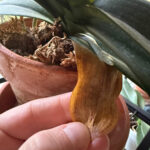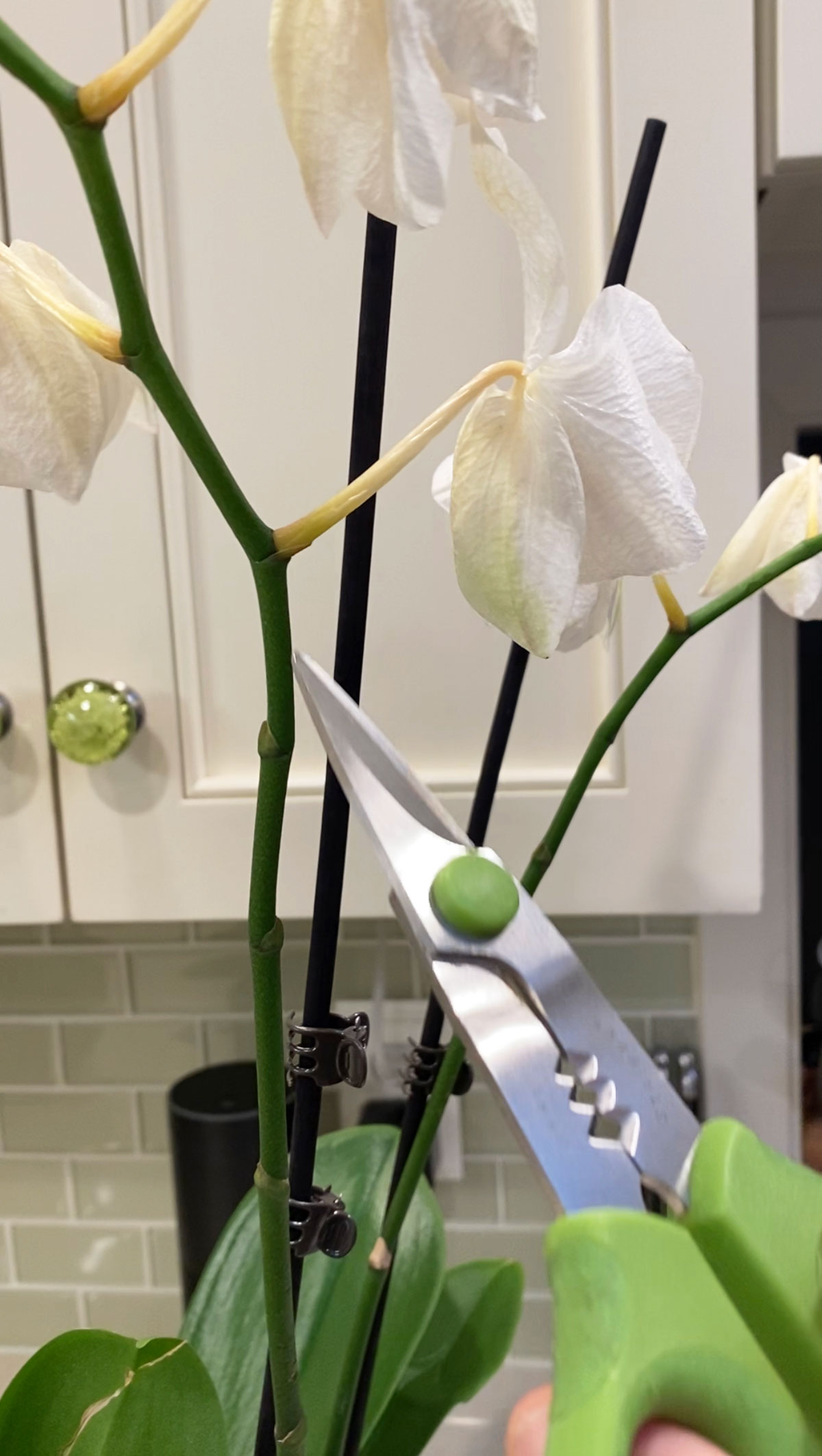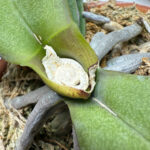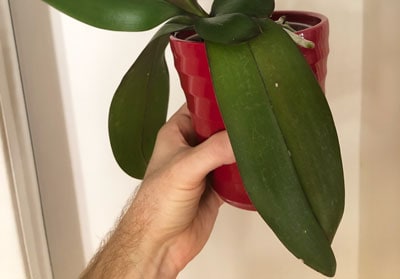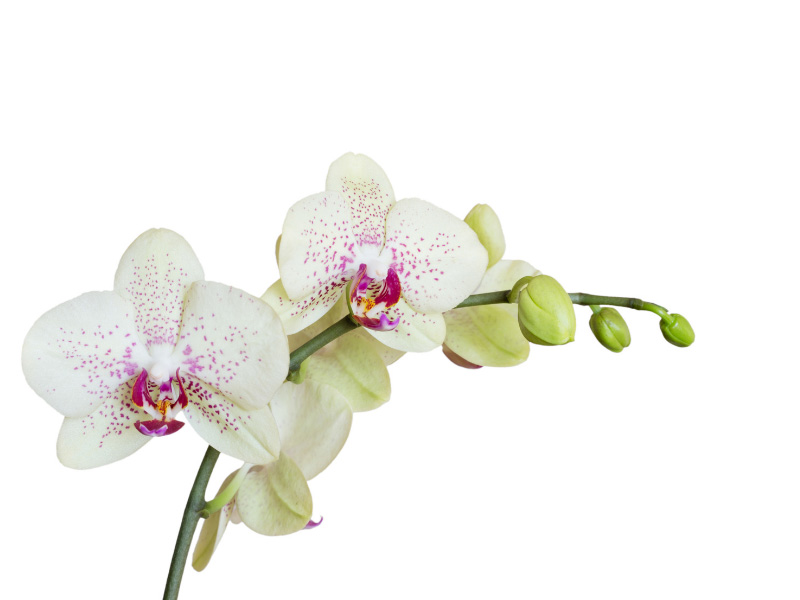Some of the links in this post may be affiliate links.
Is your moth orchid losing leaves left and right and you’re not sure what’s going on? In this post, I talk about 9 of the most common reasons why your Phalaenopsis orchids are losing their leaves, and what you can do about it.
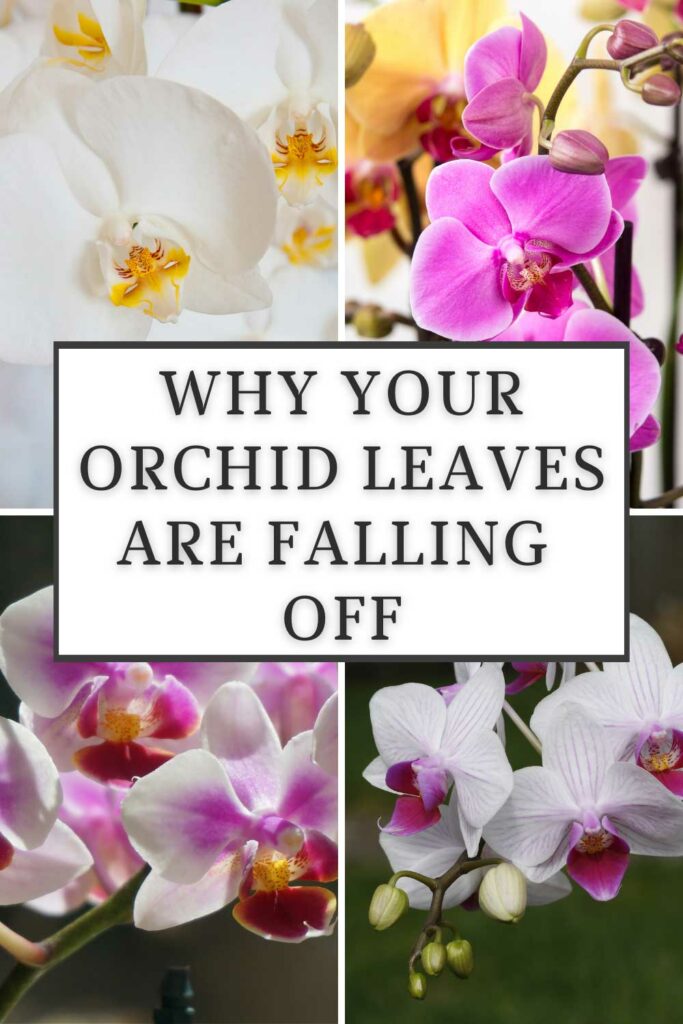
Table of Contents
Table of Contents
REASONS FOR ORCHID LEAVES FALLING OFF
There are many reasons why your orchid leaves are falling off. As long as you have at least one green leaf, it may be worth it to you to revive your plant.
If your plant has lost all of its leaves, it’s best to just throw your plant away and start with a new one. Moth orchids grow so slowly and grow so few new leaves per year that they’re not worth saving if the damage has gone too far.
Here are 9 of the most common reasons why your Phalaenopsis orchids are losing leaves.
1. DEHYDRATED
A persistent lack of water will quickly harm your moth orchid. After your plant has stayed dry for too long, the drought stress will cause the lower leaves to start to yellow.
Once you have yellow leaves, they will not turn green again and will eventually dry up and fall off.
While it is normal for older leaves to eventually turn yellow and fall off, this will quickly happen if your orchid has gone bone dry.
To confirm that your potting medium is dry, the best way to tell is to stick your finger in the potting medium (typically it will be either sphagnum moss or a bark mix). If it feels bone dry, it has gone too dry.
In addition to the lower leaves yellowing, you will also notice that the entire plant will start to droop, even the green leaves. You may also notice that the orchid leaves are wrinkled.
Healthy roots should look plump and grayish-white, and often have green tips.
Another indication of dehydration is that the aerial roots will appear very wrinkled and dry to the touch.
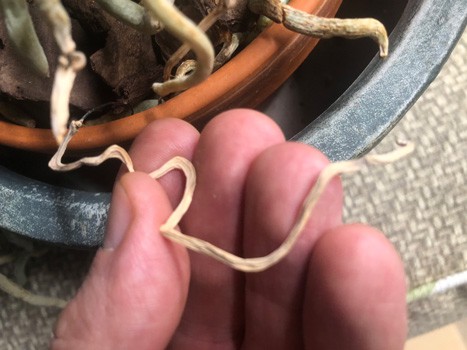
Since moth orchids do not have water-storing pseudobulbs like many other orchids, special attention needs to be taken to ensure that they receive enough water. They are simply not drought-tolerant.
Assuming that you still have some green leaves, even though they may be droopy, you can still save your plant with time and patience.
Check out my blog post on the best ways to water your orchids. I recommend implementing method #2 in the post weekly if your orchid plant is growing in a bark mix.
Once an orchid is stressed, it will take a long time to recover and will take plenty of patience and consistency in care for it to slowly bounce back. Increasing humidity during this time will help its recovery.
Other than a bark mix, the other popular potting medium for orchids is plain sphagnum moss. If your plant is growing in sphagnum moss, check out my post on watering orchids growing in moss for the best tips.
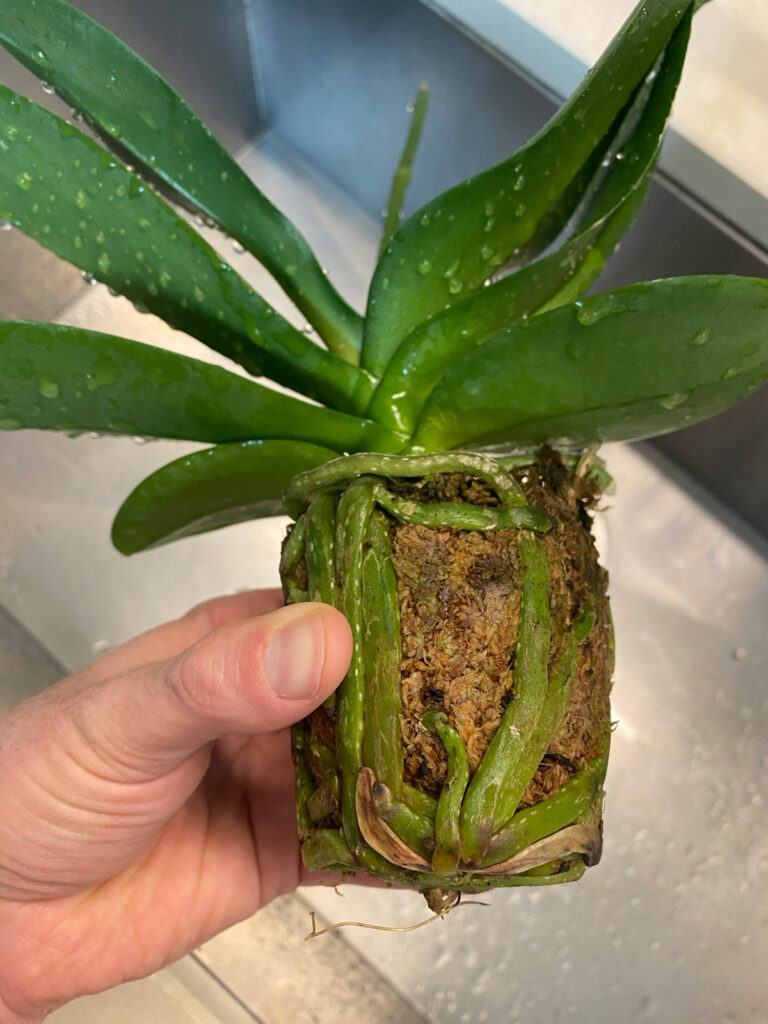
If you want to learn all about how to get your orchid to rebloom reliably and have healthy, thriving moth orchid plants, don’t miss my signature, online orchid care course, Become an Orchid Master. It also includes bonuses with support from me, personally, to guide you in your orchid journey!
2. “OVERWATERED”
Perhaps you have the opposite problem of a dehydrated orchid and you have an overwatered orchid. I really don’t like the word “overwatered” because I believe it drives the wrong behavior in watering and makes people scared to water properly.
Instead of “overwatered,” I prefer to think of it as your potting medium staying wet for too long. Depending on your growing conditions, the potting mix can stay wet for too long for a number of reasons.
Orchids love quite a bit of water, but they need to dry out somewhat in between watering. If your plant is perpetually wet, it will cause root rot.
Rotted orchid roots will be mushy and soft and appear brown or black.
The most common reasons why your orchid’s roots are rotting which I’ve observed after helping countless people, is simply because the plant owners allow water to accumulate at the bottom of the pot and fail to discard excess water.
Orchids can NOT sit in standing water for extended periods of time. I’ve found that this commonly occurs when people keep watering their orchids with ice cubes and fail to discard accumulated water at the bottom of the decorative pot.
(And on that note, I do NOT recommend watering your orchids with ice!)
Normally when you purchase an orchid, it is growing in a clear plastic pot with drainage holes, and it is slipped inside of a decorative pot that has no drainage holes. It is easy for water to accumulate at the bottom and you need to discard excess water so your plant doesn’t rot.
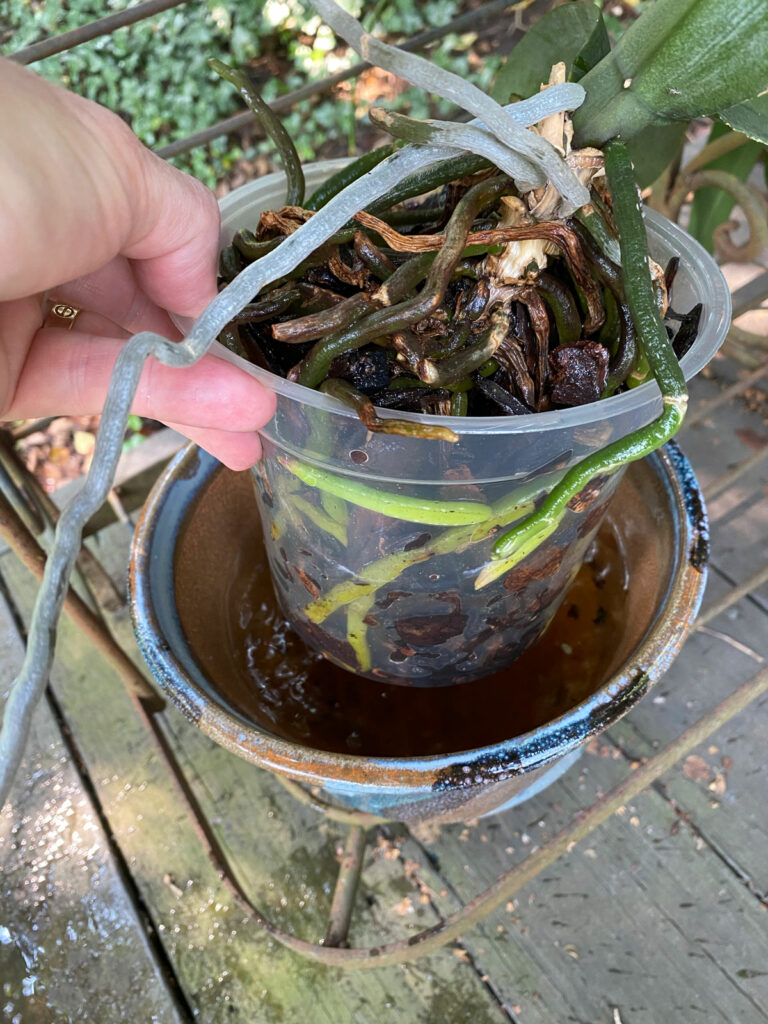
Please note that your orchid plant will look similar, whether you’ve dehydrated it or you “overwatered” it. Leaves will be limp and droopy, and they will also probably be wrinkled and there will be some yellowing of the leaves. So how do you know what happened?
You’ll have to observe your plant and stick your finger in the potting mix. If you see an orchid in distress and the potting mix feels wet and your orchid roots are rotted, then you’ve “overwatered.”
Another reason why your potting medium may have stayed wet for too long is if you haven’t repotted your orchid in a long time and the potting mix has broken down.
This is a particular problem with a bark mix. After it breaks down, orchid roots will suffocate and rot. Moth orchids are epiphytes and grow on trees in nature, with their root system exposed, so they don’t do well with potting mixes that have decomposed and therefore have dramatically less air circulating around their roots.
It is good practice to repot orchids growing in a bark mix about every 2-3 years or so.
If your orchid has root rot, I recommend removing your plant from its pot and carefully cut off any rotted, dead roots. Then, discard all of the potting mix, and repot it into a fresh growing medium.
3. PESTS
If you let pests go out of control, this also can cause a loss of leaves. Some of the most common pests that attack moth orchids are mealybugs and scale.
Mealybugs will appear as white, cottony masses on your plant. Scale insects can have either soft or hard domes and leave a sticky substance called honeydew on the leaves.
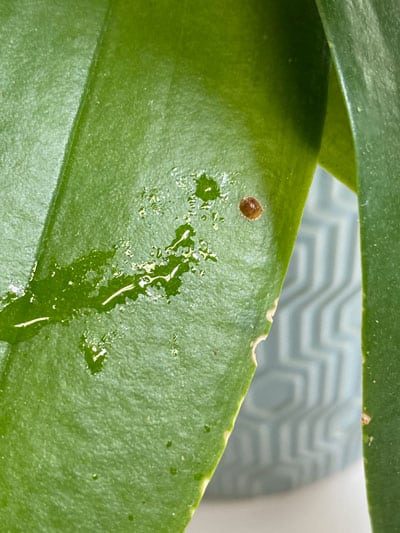
If detected and treated early, pests can be best managed this way. If infestations get really bad, it’s probably best to through the plant away. It’s not worth the extra work, not to mention the risk of pests spreading to your other plants.
Mealy bugs and scale can both be treated with a good insecticidal soap, among others.
4. DISEASES
Your orchid can also lose leaves as a result of a bacterial infection or fungal infection. If you see any discoloration, brownish spots, or even rings around discolored areas of your orchid’s leaves, you may have a bacterial or viral infection.
To me, unless you have a special specimen, it is best to discard your plant.
For reference, check out the American Orchid Society’s post on orchid ailments which details quite a few pests and diseases.
5. NOT ENOUGH LIGHT
A lack of light can eventually cause the lower leaves to yellow, even all your other conditions seem good.
This will happen particularly if you have purchased a beautiful plant in full bloom and you take it to a dark location of your home.
With a huge reduction in light, your plant can no longer support all of its foliage, especially after being grown in the ideal conditions of a commercial orchid grower’s greenhouse.
A great place to situate your orchid is right in front of an eastern or western-facing window. A little bit of direct sun indoors will benefit these plants.
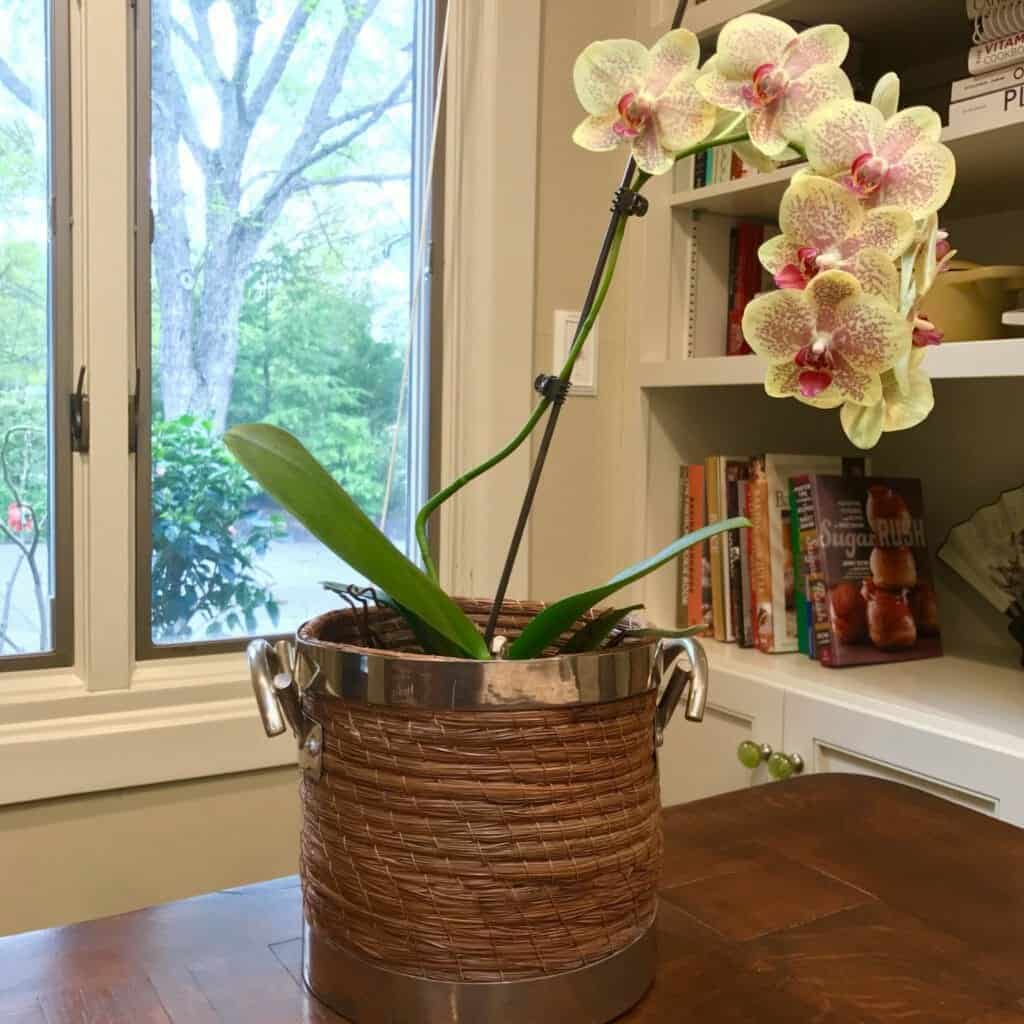
6. TOO MUCH LIGHT
Too much light can cause your orchid leaves to scorch and eventually fall off if the damage is bad enough. And oftentimes, it is simply because your plant hasn’t been acclimated to higher light slowly enough.
This is often the case when people move their orchids outdoors after they’ve spent a long time indoors. If you’re moving orchids outdoors, place them in full shade first for a several days.
After that point, you can give them dappled sun or a little direct sun (especially gentler morning sun). They do not want to be in full sun outside, but they can take a little bit.
Indoors, it’s pretty difficult to burn your orchid leaves, unless you live in an area with very strong sun and your plant is sitting in full sun all day.
In most climates, moth orchids can take a few hours of direct sun easily indoors! The intensity of direct sun indoors is dramatically less than it is outdoors.
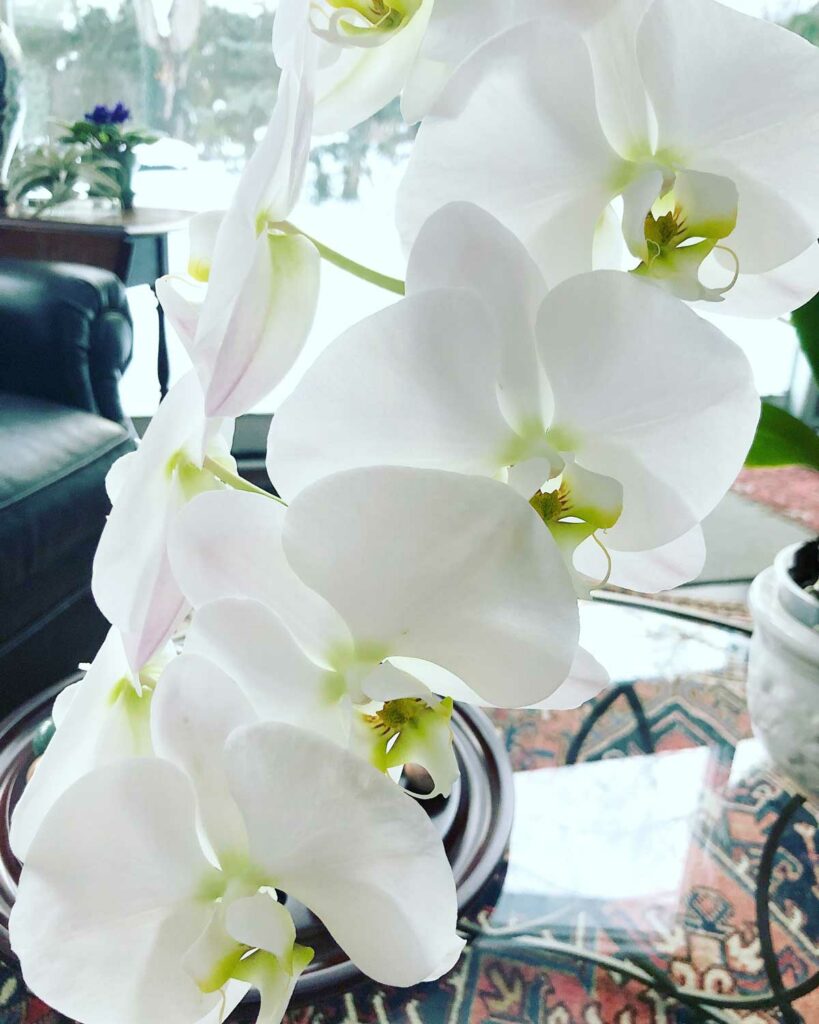
7. COLD TEMPERATURES
Cold temperatures can quickly cause yellow leaves in orchids and other plants as well. Phalaenopsis orchids are tropical plants and are happiest in the 60-85°F (approximately 16-29°C) temperature range.
Do not expose them to temperatures much below 55°F, and even then, just as minimum night-time temperatures for a few weeks. This is actually beneficial in initiating flower spikes.
Avoid any temperature exposure below 50°F (10°C) as this will quickly cause your orchid to go downhill.
8. CROWN ROT
This condition is where the crown of the plant (the center of the plant where new leaves grow out of) starts to rot.
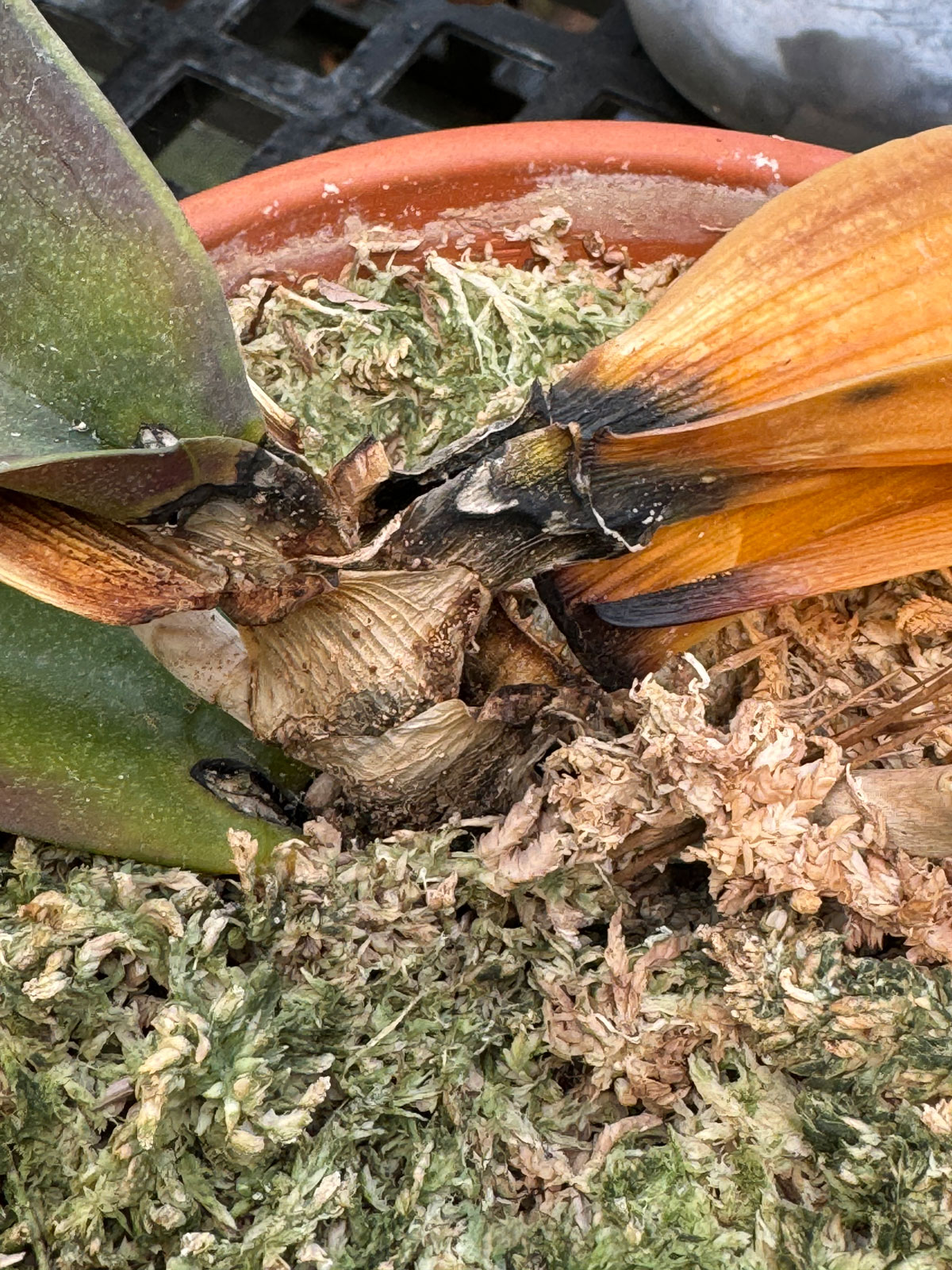
Once this occurs, your plant is probably a goner and you should throw it away. What causes crown rot?
If water sits in the crown of the plant for a long time, it can cause crown rot and it will essentially kill the entire plant. In order to avoid this, when you water your orchid, make sure that you remove any water sitting in the crown of the plant.
You can stick your face it the crown like I do and huff and puff a couple times. Or you can dry any standing water with a paper towel or sponge, or simply tip your plant over to drip away excess water.
Crown rot can be encouraged if your plant is in an area that has stagnant air and little to no air circulation. This, coupled with water stuck in the crown, can cause crown rot.
Check out my blog post on what to expect from an orchid with crown rot. It won’t necessarily die!
9. FERTILIZER BURN
This is only a concern if you have grossly overestimated the amount of fertilizer that you’ve given your plant. The moral of the story is to ALWAYS measure your fertilizer and water amount.
Never eyeball the amounts! Fertilizer burn is real, and if it’s bad enough, you can kill your plants.
I have a dedicated set of measuring spoons so I can measure the correct amount of fertilizer, and I also measure my water either in a gallon jug or gallon watering can.
I hope you’ve enjoyed this post on orchid leaves falling off and came away with some valuable take-aways.

